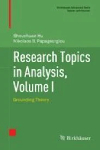- About MAA
- Membership
- MAA Publications
- Periodicals
- Blogs
- MAA Book Series
- MAA Press (an imprint of the AMS)
- MAA Notes
- MAA Reviews
- Mathematical Communication
- Information for Libraries
- Author Resources
- Advertise with MAA
- Meetings
- Competitions
- Programs
- Communities
- MAA Sections
- SIGMAA
- MAA Connect
- Students
- MAA Awards
- Awards Booklets
- Writing Awards
- Teaching Awards
- Service Awards
- Research Awards
- Lecture Awards
- Putnam Competition Individual and Team Winners
- D. E. Shaw Group AMC 8 Awards & Certificates
- Maryam Mirzakhani AMC 10 A Awards & Certificates
- Two Sigma AMC 10 B Awards & Certificates
- Jane Street AMC 12 A Awards & Certificates
- Akamai AMC 12 B Awards & Certificates
- High School Teachers
- News
You are here
Research Topics in Analysis, Volume I

Publisher:
Birkhäuser
Publication Date:
2022
Number of Pages:
548
Format:
Hardcover
Price:
89.99
ISBN:
978-3031178368
Category:
Textbook
[Reviewed by , on ]
John Ross
06/17/2023
Research Topics in Analysis, Volume 1: Grounding Theory is the first of two volumes that offer mathematicians tools used in the modern research fields of analysis. Shouchuan Hu and Nikolaos Papageorgiou aim for these texts to empower researchers with “all the necessary techniques to explore the various subfields of this broad subject,” while also providing “relevant frameworks where these tools can be immediately deployed.” This is an ambitious and worthwhile undertaking. I suspect that, armed with both texts, the analyst will have access to a wealth of tools and techniques for approaching analysis problems. Taken as a single text, Volume 1 offers a deep (and dense) dive into the standard foundational material in analysis. I suspect that the volume would be too dense for a first pass on this material, but would serve handily as a reference (and hypothesize that, in conjunction with Volume 2, it will serve well for the modern researcher).
Grounding Theory, as the name suggests, focuses primarily on the graduate-level subjects that lay the groundwork for the broad field of research analysis. With so much to cover, each chapter offers a relatively complete overview of its material, albeit at a blistering pace. For example, the first half of the text is comprised of four chapters that cover topology, measure theory, Banach space theory, and function spaces; each of these subjects is easily worthy of an entire text of its own, and to cover all four in under 300 pages is quite a feat. To achieve this, the authors acknowledge that they focus “only on the essential aspects, which are used in applications,” and that readers will gain a panoramic view of the subjects “without getting carried away in details that are not relevant.”
This treatment continues through the next four chapters, which are focused on more concrete applications: these chapters cover set-valued functions, smooth and nonsmooth calculus, nonlinear operators, and variational analysis. While I think the first four chapters might move through their subject matter too quickly, I admit that I really appreciate these later chapters of the text. I found that they provided a nice crash course in their respective topics.
This is certainly not a volume for the faint of heart, and probably serves better as a reference than as a true primer on many of the topics present within. The treatment of the material within each chapter can certainly be described as “compact,” and the exercises are often challenging. As such, I do not think I would recommend this text as a standalone text for any student who is trying to learn this material for the first time. However, for a researcher looking to be refreshed on these topics within the field of analysis, and looking to springboard their understanding of current research fields, I believe Volume 1 could be a valuable reference – and although I have not seen Volume 2 yet, I conjecture that, once paired, the two-volume set will make an excellent tool for researchers looking to quickly gain insight into the tools used in modern analytical research.
John Ross is an assistant professor of mathematics at Southwestern University.
See the publisher's website.
- Log in to post comments




